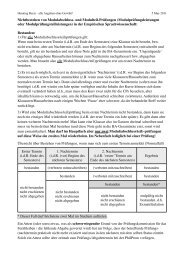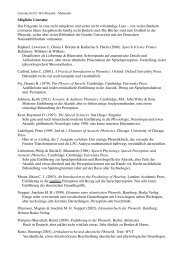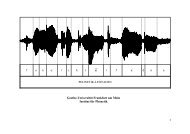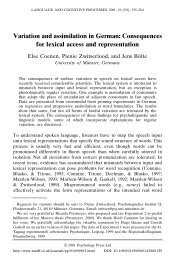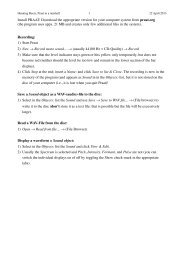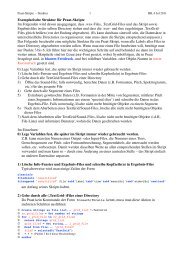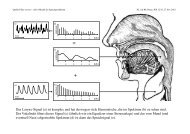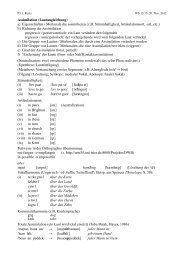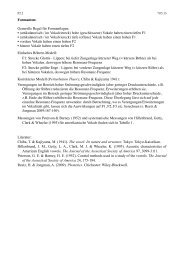Language and Cognitive Processes - Institut für Phonetik
Language and Cognitive Processes - Institut für Phonetik
Language and Cognitive Processes - Institut für Phonetik
Create successful ePaper yourself
Turn your PDF publications into a flip-book with our unique Google optimized e-Paper software.
Downloaded By: [Universitaetsbibliothek] At: 15:27 19 June 2007<br />
378 SPINELLI, SEGUI AND RADEAU<br />
Discussion<br />
For partial priming, facilitation was found only for prime words<br />
overlapping with targets in the initial syllable; no priming was observed<br />
for primes overlapping in the second syllable. The fact that the initial<br />
facilitation effect remains when the target is visually presented supports<br />
the idea that the lexical representation of the target is activated during the<br />
processing of the prime. Indeed, if we suppose that the 50 ms interstimulus-interval<br />
between the end of the prime <strong>and</strong> the presentation of the<br />
target is not long enough to be processed as mismatching information, the<br />
target occurs while it is still activated by the prime. This preactivation of<br />
the lexical representation of the target would then be responsible for the<br />
initial-overlap facilitation effect.<br />
For nal overlap, the lack of facilitation is compatible with previous<br />
results in the literature, as nal phonological overlap effects have never<br />
been reported with a crossmodal paradigm. These results thus argue in<br />
favour of the idea that the processes responsible for the nal overlap<br />
facilitation involve only the activation of sublexical units. The nal<br />
facilitation obtained in auditory-auditory priming could be due to the fact<br />
that primes <strong>and</strong> targets share a number of sublexical units. This means that<br />
although hearing tige would facilitate the subsequent processing of vertige,<br />
it would not activate its lexical representation.<br />
In the condition of bisyllabic priming, the beginning overlap condition<br />
did not give rise to any facilitation of target processing. Hence, depending<br />
on the nature of the prime (monosyllabic as in ‘‘ver-vertige’’ or bisyllabic<br />
as in ‘‘verger-vertige’’), we observed either facilitation or no effect,<br />
respectively. Moreover, although not signicant, the results with bisyllabic<br />
primes suggest inhibition rather than facilitation. According to our<br />
interpretation, when the prime was a monosyllabic word, the target<br />
received bottom up activation from the prime <strong>and</strong> remained activated<br />
because there was no mismatching information in the acoustic realisation<br />
of the prime. Thus, the representation of the preactivated target was not<br />
deactivated when the target was presented. On the contrary, when the<br />
prime was a bisyllabic word, it induced deactivation of the target. In the<br />
case of ‘‘verger-VERTIGE’’, hearing the beginning of the prime would<br />
send bottom up activation to a cohort of c<strong>and</strong>idates beginning by ‘‘ver’’,<br />
but during the processing of ‘‘g’’ in ‘‘verger’’, the word ‘‘vertige’’ would<br />
start to be deactivated or inhibited. Thus, at the end of the prime ‘‘verger’’,<br />
the word ‘‘vertige’’ would no longer be activated when subsequently<br />
presented as a target.<br />
Our results are compatible with those reported by Zwitserlood (1989)<br />
who found that the two semantically related targets ‘‘geld’’ (money in<br />
Dutch) <strong>and</strong> ‘‘boot’’ (ship) were facilitated when presented during the /t/ of




